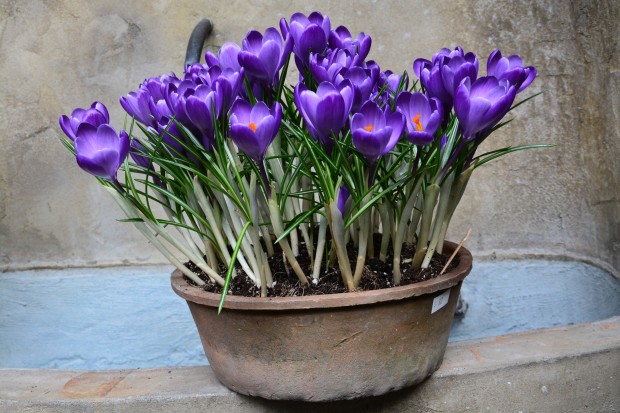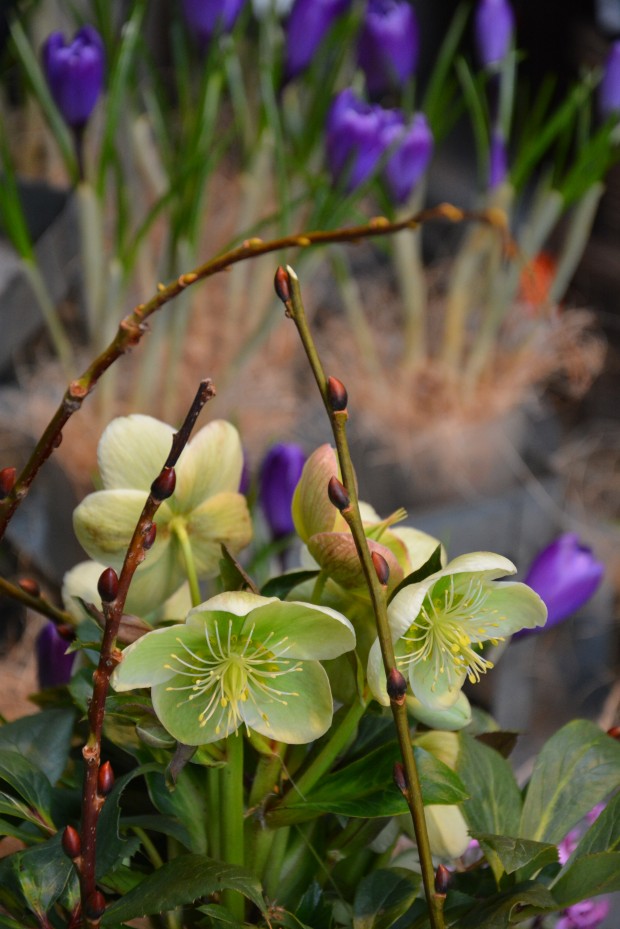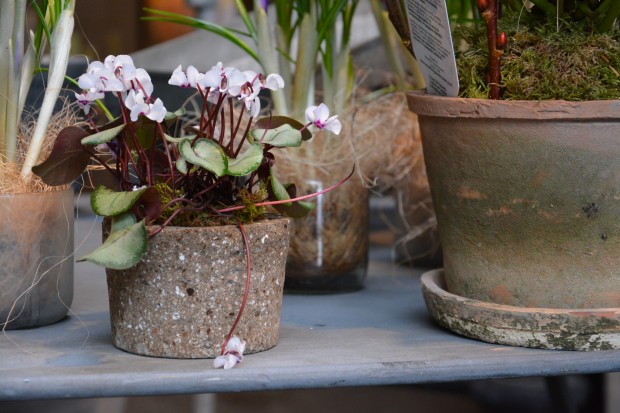Archives for 2014
Culture

Don’t let the title of this post make you think I am all in and over my head. I have no plan to discuss culture, as in the cumulative arts and intellectual achievement of a neighborhood or nation or region or era. I would be over my head. I am interested in culture as the process of making something grow. Scientists are able to culture bacteria in a petrie dish, loaded with whatever medium known to make bacteria thrive. Knowing what it takes to make bacteria multiply may help to discover what might starve them off. Cultivation is an agricultural term dating back centuries. Farmers do what they can to provide optimal growing conditions for the seeds of any plant they wish to grow. Gardeners cultivate plants in their garden. Any plant you choose to grow the idea implies a willingness to provide optimal conditions.
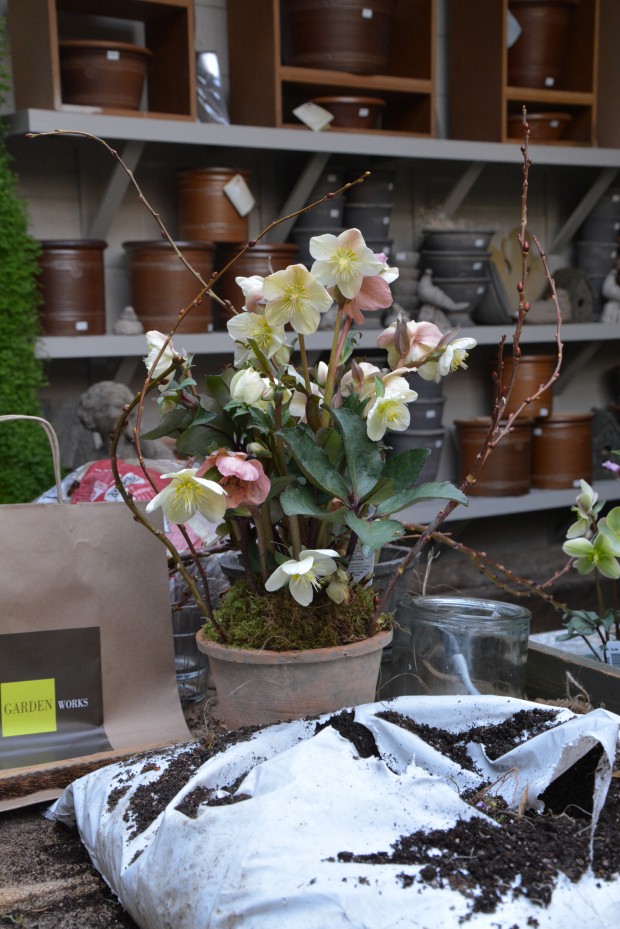 The plant of my current moment is helleborus orientalis, and its hybrids. A cultivar is a shortened version referring to cultivated varieties. Some hybrids of hellebores have poor foliage, or are shy bloomers. Others are not especially hardy, or the flowers may be buried in the foliage. Some cultivars have muddy colors, or poor form. Others have no inclination to grow. Plant breeders are an individual lot. They have a very personal and usually very long range plan to breed cultivars that grow vigorously, bloom profusely, are hardy and disease resistant. Every breeder has a different idea of what constitutes the holy grail.
The plant of my current moment is helleborus orientalis, and its hybrids. A cultivar is a shortened version referring to cultivated varieties. Some hybrids of hellebores have poor foliage, or are shy bloomers. Others are not especially hardy, or the flowers may be buried in the foliage. Some cultivars have muddy colors, or poor form. Others have no inclination to grow. Plant breeders are an individual lot. They have a very personal and usually very long range plan to breed cultivars that grow vigorously, bloom profusely, are hardy and disease resistant. Every breeder has a different idea of what constitutes the holy grail.
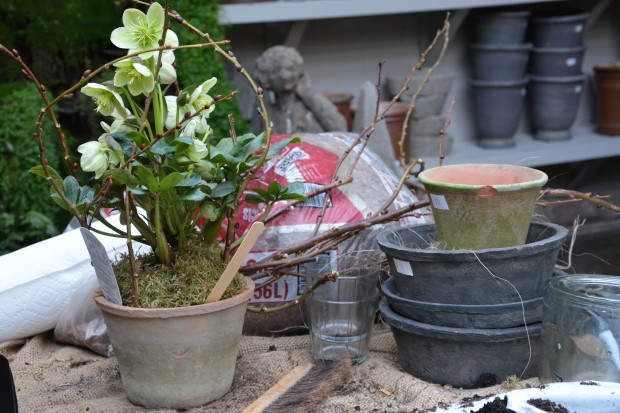 Helleborus orientalis and its related hybrids or cultivars thrive in light to medium shade, in well draining compost rich soil that has a source of regular moisture. My hellebores are planted in full sun, but I am careful to provide additional water during dry spells. I do not fuss over them much. If you cultivate hellebores in conditions that approximate their ideal siting, they will probably do well. The not fussing has a deeper meaning. Plants that appreciate and thrive in compost rich soil implies they like places where the falling leaves are allowed to rot. Those places not subject to an inordinate amount of cleanup.
Helleborus orientalis and its related hybrids or cultivars thrive in light to medium shade, in well draining compost rich soil that has a source of regular moisture. My hellebores are planted in full sun, but I am careful to provide additional water during dry spells. I do not fuss over them much. If you cultivate hellebores in conditions that approximate their ideal siting, they will probably do well. The not fussing has a deeper meaning. Plants that appreciate and thrive in compost rich soil implies they like places where the falling leaves are allowed to rot. Those places not subject to an inordinate amount of cleanup.
 I do not cultivate the soil around my hellebores. If a hellebore is inclined to seed, it will do so with abandon. Scraping the surface in anticipation of weeds might well eliminate any seeding.. Turning the soil may turn under all the germinated babies. Even hybrids of helleborus orientalis resent too much attention. Most plants come equipped with an incredible will to live, standard issue. I cultivate my landscape with as light a hand as I can manage. I try not to interfere too much, unless there is a genuine call to action.
I do not cultivate the soil around my hellebores. If a hellebore is inclined to seed, it will do so with abandon. Scraping the surface in anticipation of weeds might well eliminate any seeding.. Turning the soil may turn under all the germinated babies. Even hybrids of helleborus orientalis resent too much attention. Most plants come equipped with an incredible will to live, standard issue. I cultivate my landscape with as light a hand as I can manage. I try not to interfere too much, unless there is a genuine call to action.
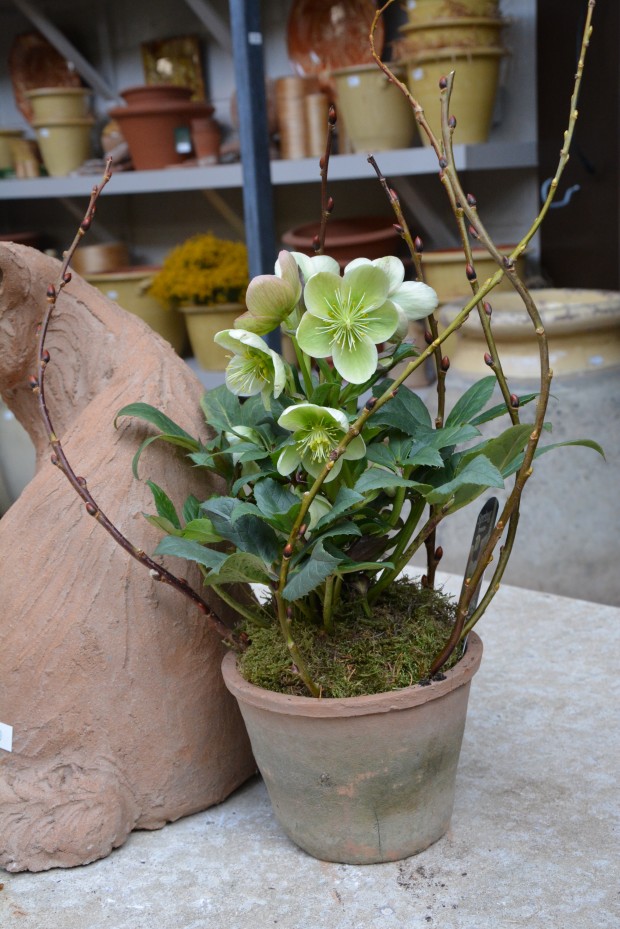 If you would like to grow hellebores, chances are you have a spot. As beautiful as they are, they are not so fussy. Deep shade means you will have fewer flowers. Deep and dry sandy shade-they don’t love this so much. Maybe another species of hellebore would be better, if this describes your conditions. A quiet spot in compost laden spongy soil in light shade-just about perfect. I try to site my plants in locations that I believe will encourage them to grow and prosper. This is plant culture.
If you would like to grow hellebores, chances are you have a spot. As beautiful as they are, they are not so fussy. Deep shade means you will have fewer flowers. Deep and dry sandy shade-they don’t love this so much. Maybe another species of hellebore would be better, if this describes your conditions. A quiet spot in compost laden spongy soil in light shade-just about perfect. I try to site my plants in locations that I believe will encourage them to grow and prosper. This is plant culture.
 As for the hellebores in the greenhouse now at Detroit Garden Works, we keep the space cool. We run our greenhouse fans non stop. Good air circulation is a good idea for perennial plants being cultivated indoors. We don’t water these leathery leaved plants until they really need it.
As for the hellebores in the greenhouse now at Detroit Garden Works, we keep the space cool. We run our greenhouse fans non stop. Good air circulation is a good idea for perennial plants being cultivated indoors. We don’t water these leathery leaved plants until they really need it.
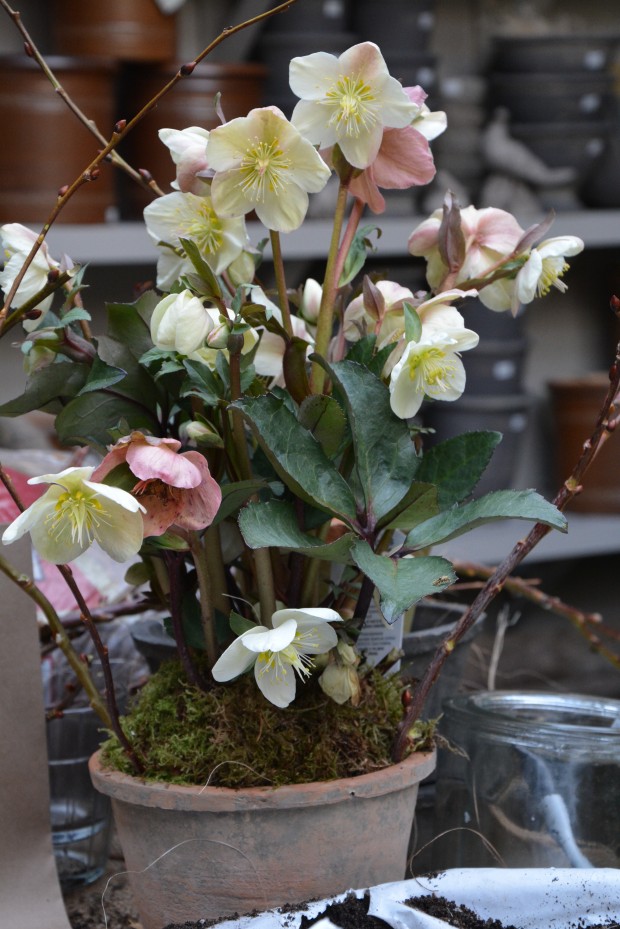 The requirements for the successful cultivation of hellebores in the garden don’t so much apply to growing them in pots. They make a great centerpiece for a spring container for a sunny window. Rob has been potting them up all day today. He has chosen to pair these blooming cultivars with cut stems of curly pussy willow, and a top dressing of natural moss.
The requirements for the successful cultivation of hellebores in the garden don’t so much apply to growing them in pots. They make a great centerpiece for a spring container for a sunny window. Rob has been potting them up all day today. He has chosen to pair these blooming cultivars with cut stems of curly pussy willow, and a top dressing of natural moss.
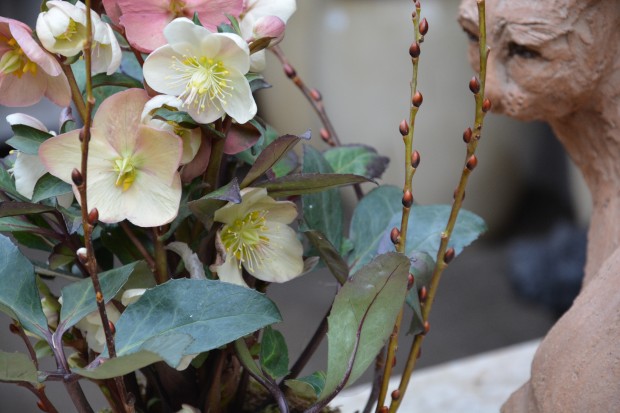 The hellebores in the ground in my garden are buried under 5 feet of snow-this is today’s news. I cannot begin to predict how my hellebore garden will do or not do this spring. This has been a winter with which I have no familiarity or experience. In the meantime, am enjoying potting up hellebores in a way I believe will hold them just fine until I can work the soil in my garden. Rob has paired his hellebore pots with fresh cut shoots of curly pussy willow. He is cultivating spring, as only he can.
The hellebores in the ground in my garden are buried under 5 feet of snow-this is today’s news. I cannot begin to predict how my hellebore garden will do or not do this spring. This has been a winter with which I have no familiarity or experience. In the meantime, am enjoying potting up hellebores in a way I believe will hold them just fine until I can work the soil in my garden. Rob has paired his hellebore pots with fresh cut shoots of curly pussy willow. He is cultivating spring, as only he can.
Potting Up
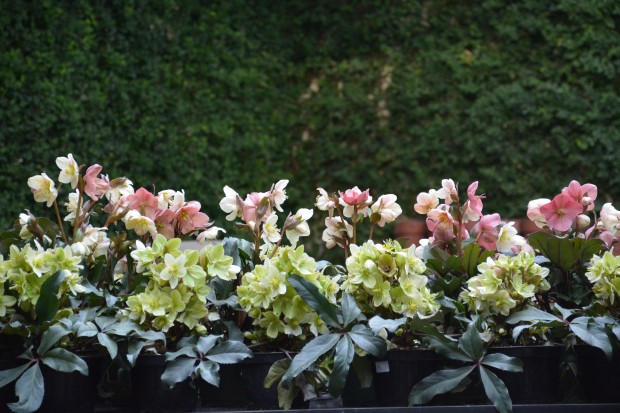 Our winter is stuck on repeat like a CD playing with a giant gouge-is it not? If only nature would choose to bring this song to a close. If only the channel would change. OK, I realize the timing of the change of the channel is out of my control. The only thing keeping me on an even keel-a greenhouse full of hellebores. I am on the verge of being afraid for spring. The sun and slightly warmer temperatures today meant melted snow was streaming into the shop under the front door. What other disasters does this brutal winter have to visit upon our spring? I don’t have any answers, just a lot of theories that are most likely off target or irrelevant. March? lion-like, so far. And no relief in sight. But any gardener has the option of creating a little spring indoors. I am beginning to see pots of spring flowering bulbs available at nurseries.
Our winter is stuck on repeat like a CD playing with a giant gouge-is it not? If only nature would choose to bring this song to a close. If only the channel would change. OK, I realize the timing of the change of the channel is out of my control. The only thing keeping me on an even keel-a greenhouse full of hellebores. I am on the verge of being afraid for spring. The sun and slightly warmer temperatures today meant melted snow was streaming into the shop under the front door. What other disasters does this brutal winter have to visit upon our spring? I don’t have any answers, just a lot of theories that are most likely off target or irrelevant. March? lion-like, so far. And no relief in sight. But any gardener has the option of creating a little spring indoors. I am beginning to see pots of spring flowering bulbs available at nurseries.
 This pot of muscari came in a plastic pot. No gardener should be dismayed by the nursery presentation. What they do well is bring a plant on. Representing the magic of spring is not their thing. They grow. What they grow is available at a very reasonable cost. That bulb that has shot forth leaves and flowers is a miracle of nature. Spring flowering bulbs have flowers and leaves stored in in those juicy orbs we call bulbs. Given the proper temperature signs, those bulbs break dormancy and grow.
This pot of muscari came in a plastic pot. No gardener should be dismayed by the nursery presentation. What they do well is bring a plant on. Representing the magic of spring is not their thing. They grow. What they grow is available at a very reasonable cost. That bulb that has shot forth leaves and flowers is a miracle of nature. Spring flowering bulbs have flowers and leaves stored in in those juicy orbs we call bulbs. Given the proper temperature signs, those bulbs break dormancy and grow.
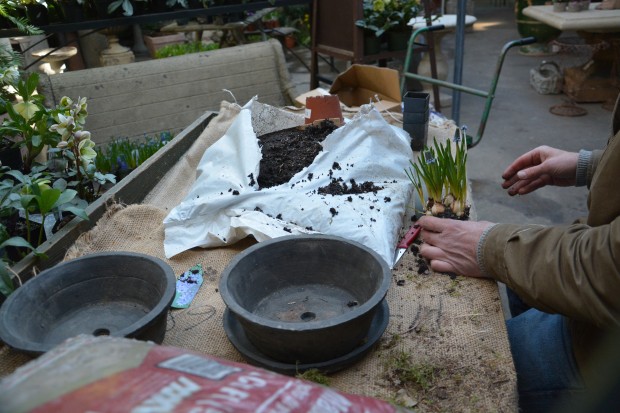 Not so much is required of a gardener to bring a spring flowering bulb into bloom. Tulips, daffodils, hyacinths,and a whole host of small flowering bulbs will represent in the spring, if you can just manage to get them below ground before the ground freezes so hard it cannot be worked. I am embarrassed to say that I have had to ditch plenty too many bulbs in my gardening life, as I did not make the deadline. Happily, the fall planting deadlines need not apply, should you pot up. Pots of bulbs wintered over in the garage will come on and bloom with as much vigor as bulbs planted on time in the fall.
Not so much is required of a gardener to bring a spring flowering bulb into bloom. Tulips, daffodils, hyacinths,and a whole host of small flowering bulbs will represent in the spring, if you can just manage to get them below ground before the ground freezes so hard it cannot be worked. I am embarrassed to say that I have had to ditch plenty too many bulbs in my gardening life, as I did not make the deadline. Happily, the fall planting deadlines need not apply, should you pot up. Pots of bulbs wintered over in the garage will come on and bloom with as much vigor as bulbs planted on time in the fall.
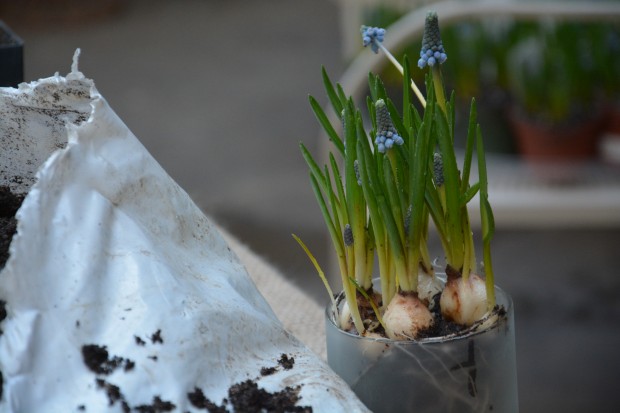 Should you have no pots of spring flowering bulbs waiting for spring in your garage, shop your favorite garden store. Rob spent the day transplanting muscari and cyclamen into containers. How he transforms a nursery grown plastic pot loaded with muscari into a strong statement about spring might interest you.
Should you have no pots of spring flowering bulbs waiting for spring in your garage, shop your favorite garden store. Rob spent the day transplanting muscari and cyclamen into containers. How he transforms a nursery grown plastic pot loaded with muscari into a strong statement about spring might interest you.
 The first time I saw him wash the soil off of the upper half of a spring flowering bulb, I worried. Would a bulb exposed to view mean disaster? That has never happened. As he says, the bulb from which all that life springs is beautiful. A statement about spring should surely include a view of that bulb that is part of the experience of spring.
The first time I saw him wash the soil off of the upper half of a spring flowering bulb, I worried. Would a bulb exposed to view mean disaster? That has never happened. As he says, the bulb from which all that life springs is beautiful. A statement about spring should surely include a view of that bulb that is part of the experience of spring.
 He has repotted cyclamen, taking great care to select a container of a proper scale. I greatly admire how he subtly pairs plants with appropriate containers.
He has repotted cyclamen, taking great care to select a container of a proper scale. I greatly admire how he subtly pairs plants with appropriate containers.
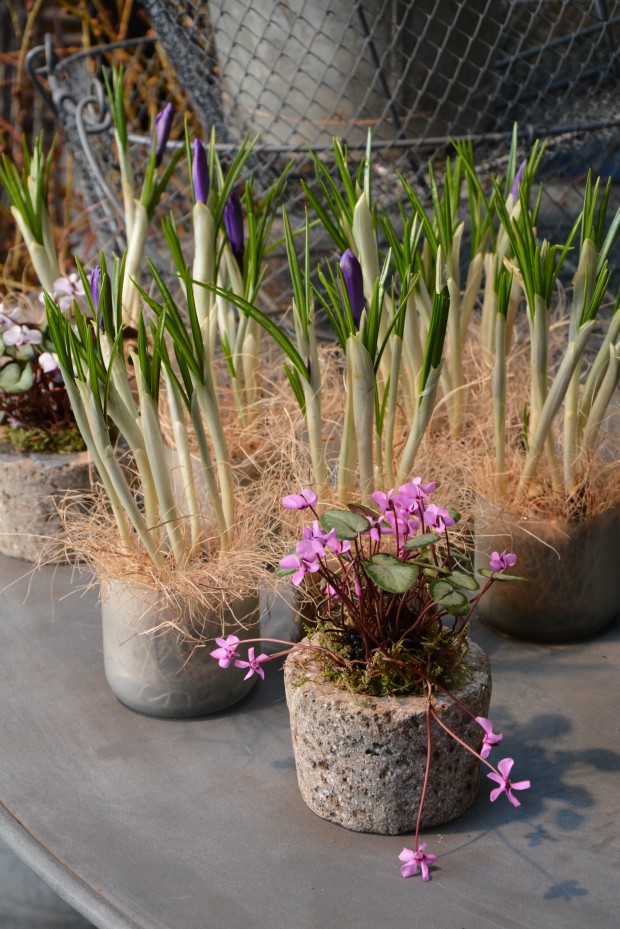 The only spring going on in my neighborhood is a direct result of the intervening hand of a passionate gardener. In our shop, those hands belong to Rob. As anxious as I am about the length of this long and very hard winter, I appreciate his gestures towards the turn of the season.
The only spring going on in my neighborhood is a direct result of the intervening hand of a passionate gardener. In our shop, those hands belong to Rob. As anxious as I am about the length of this long and very hard winter, I appreciate his gestures towards the turn of the season.
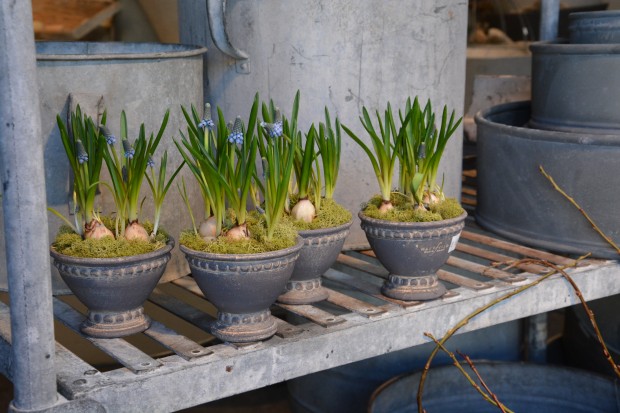 We had customers in today taking the results of his potting up home. Not near Detroit Garden Works? Visit your local nursery, and bring home a few pots of spring flowering bulbs. Then do what you can to make those pots a personal expression of spring.
We had customers in today taking the results of his potting up home. Not near Detroit Garden Works? Visit your local nursery, and bring home a few pots of spring flowering bulbs. Then do what you can to make those pots a personal expression of spring.
 Stuck in a zone with no spring?
Stuck in a zone with no spring?
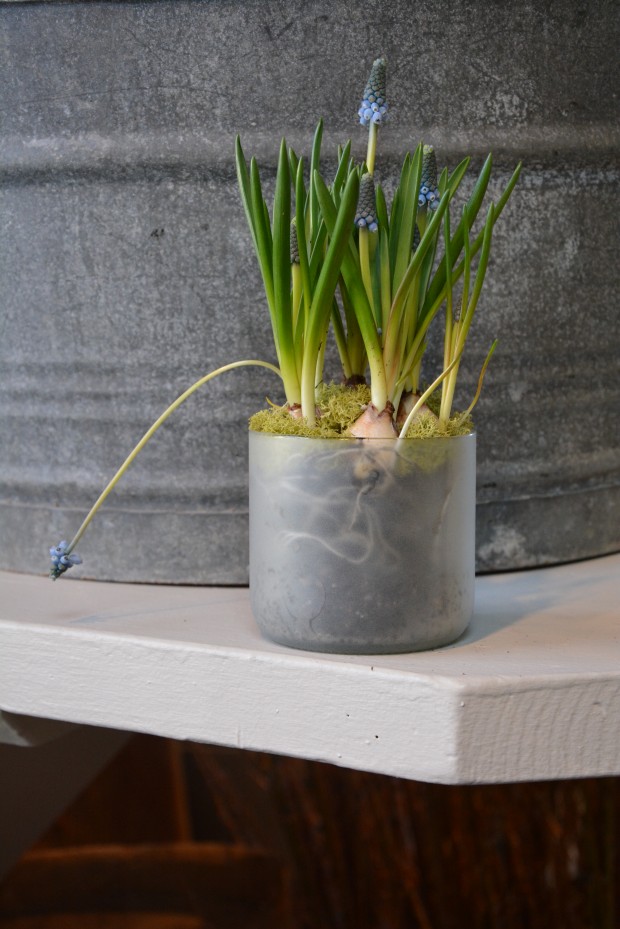 Create your own version of spring. Add a few touches from the forest floor. Take some pictures. Enjoy the process.
Create your own version of spring. Add a few touches from the forest floor. Take some pictures. Enjoy the process.
Hellebores: Recent Forms
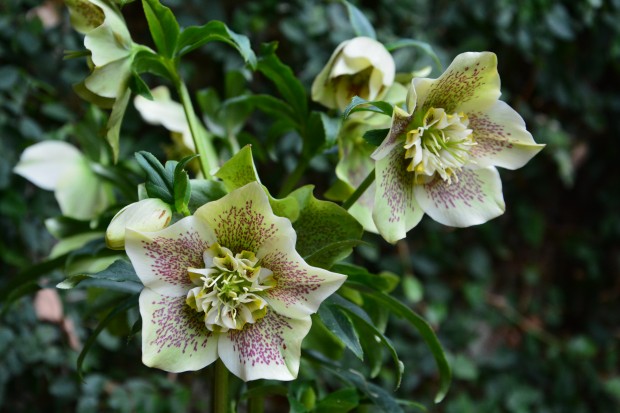 I have only been growing helleborus orientalis in my garden for 10 years or so. Why I was so late adding them to me garden is a mystery. Perhaps they were done blooming by the time I started haunting nurseries for plants. I may have missed them. Perhaps the time it took a hellebore to grow into a decent sized blooming plant was too long to make commercial production widespread. Whatever the reason, I am a fan now. They are sturdy plants with thick leather like foliage. Many of them are hardy in zone 4, which means very hardy. They thrive in light to medium shade, and like alkaline soil-perfect for my yard. In a mild winter, the foliage is evergreen. The color of the petals eventually fade, but they hold onto the stalk for a long time after the flower is spent. In June my plants will look like they are covered with green flowers. My plants are a strain grown from seed called Royal Heritage mix. This mix has been around for a fairly long time, and produces somewhat muted flowers from dark purple to pink, white and green.
I have only been growing helleborus orientalis in my garden for 10 years or so. Why I was so late adding them to me garden is a mystery. Perhaps they were done blooming by the time I started haunting nurseries for plants. I may have missed them. Perhaps the time it took a hellebore to grow into a decent sized blooming plant was too long to make commercial production widespread. Whatever the reason, I am a fan now. They are sturdy plants with thick leather like foliage. Many of them are hardy in zone 4, which means very hardy. They thrive in light to medium shade, and like alkaline soil-perfect for my yard. In a mild winter, the foliage is evergreen. The color of the petals eventually fade, but they hold onto the stalk for a long time after the flower is spent. In June my plants will look like they are covered with green flowers. My plants are a strain grown from seed called Royal Heritage mix. This mix has been around for a fairly long time, and produces somewhat muted flowers from dark purple to pink, white and green.
 Hellebores increase in size slowly, so the prices for good size plants can be considerable. The flowers emerge on leafless stalks in early spring-late March or early April in my yard. The new season’s leaves come from the ground after the flowering cycle is over. They are long lived, and make dense clumps some 18 inches tall or so. They are willing seeders, should you have the mind to grow them on. The species helleborus orientalis features nodding flowers, meaning they face down. You would have to get down on the ground to look up into their faces, or cut the flowers and float them in a bowl.
Hellebores increase in size slowly, so the prices for good size plants can be considerable. The flowers emerge on leafless stalks in early spring-late March or early April in my yard. The new season’s leaves come from the ground after the flowering cycle is over. They are long lived, and make dense clumps some 18 inches tall or so. They are willing seeders, should you have the mind to grow them on. The species helleborus orientalis features nodding flowers, meaning they face down. You would have to get down on the ground to look up into their faces, or cut the flowers and float them in a bowl.
 One can now find varieties with yellow flowers-shocking, this development. The first yellow hellebore I ever saw in person-I could not take my eyes off of it. This development was only the beginning. Breeders in Japan, England, Canada and the US (and no doubt in many other countries) are breeding plants with double flowers. Spots. picotee forms. unusual colors. Helleborus Black Oddyssey is just that-an inky black. Helleborus Ivory Price is a strong grower, and features flowers that face up. Michigan hybridizer Chris Hansen is responsible for breeding a breathtakingly beautiful group of hellebores known as “Winter Thrillers”. Improved flower color, flower size, plant vigor, and foliage are the trademark of these plants. He has been breeding hellebores for over 15 years; his newer introductions are stunning. There is a wealth of information about hellebores on line now. If you are interested, make a cup of coffee, and explore.
One can now find varieties with yellow flowers-shocking, this development. The first yellow hellebore I ever saw in person-I could not take my eyes off of it. This development was only the beginning. Breeders in Japan, England, Canada and the US (and no doubt in many other countries) are breeding plants with double flowers. Spots. picotee forms. unusual colors. Helleborus Black Oddyssey is just that-an inky black. Helleborus Ivory Price is a strong grower, and features flowers that face up. Michigan hybridizer Chris Hansen is responsible for breeding a breathtakingly beautiful group of hellebores known as “Winter Thrillers”. Improved flower color, flower size, plant vigor, and foliage are the trademark of these plants. He has been breeding hellebores for over 15 years; his newer introductions are stunning. There is a wealth of information about hellebores on line now. If you are interested, make a cup of coffee, and explore.
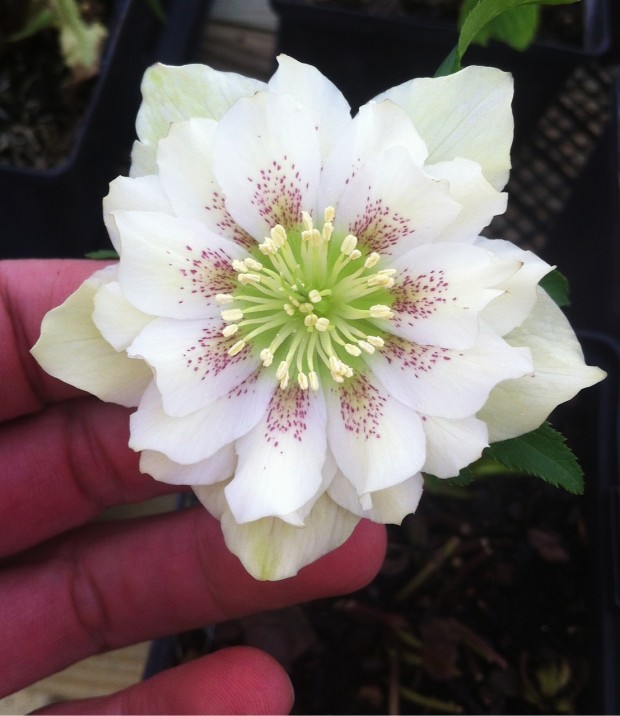 I have never been so much a fan of double flowers. The singles just appeal to me more. This is a preference that is being challenged by the new varieties of double hellebores. A flower such as this is very hard to pass by. A fan of double bloodroot might well be taken with this hellebore. Many of the newer named hellebores are available via the technology of tissue culture. Helleborus orientalis hybrids of old were all seed strains. No technology existed to exactly reproduce a particular plant. Not that I do not treasure seed strains of hellebores. There is always the chance of once in a lifetime spectacular plant. No one discusses the beauty of seed strains better than Carolyn from Carolyn’s Shade Garden.
I have never been so much a fan of double flowers. The singles just appeal to me more. This is a preference that is being challenged by the new varieties of double hellebores. A flower such as this is very hard to pass by. A fan of double bloodroot might well be taken with this hellebore. Many of the newer named hellebores are available via the technology of tissue culture. Helleborus orientalis hybrids of old were all seed strains. No technology existed to exactly reproduce a particular plant. Not that I do not treasure seed strains of hellebores. There is always the chance of once in a lifetime spectacular plant. No one discusses the beauty of seed strains better than Carolyn from Carolyn’s Shade Garden.
 A love for seed strains of hellebores implies a gardener that can successfully bring on seedlings or grow successfully from seed (I am thinking Joseph Tychonievich who grows for Arrowhead Alpines in Michigan)-or that gardener who is intrigued by the prospect of a seedling that is yet to flower. Not your thing? Lots of hellebores are available true to name-meaning they are being reproduced by tissue culture. I do have a few plants from my Royal heritage mix that are extraordinary in plant habit and bloom-others are not so swell. This named cultivar, Anna’s Red, is an outstanding plant. It was named after Anna Pavord, UK gardener and writer.
A love for seed strains of hellebores implies a gardener that can successfully bring on seedlings or grow successfully from seed (I am thinking Joseph Tychonievich who grows for Arrowhead Alpines in Michigan)-or that gardener who is intrigued by the prospect of a seedling that is yet to flower. Not your thing? Lots of hellebores are available true to name-meaning they are being reproduced by tissue culture. I do have a few plants from my Royal heritage mix that are extraordinary in plant habit and bloom-others are not so swell. This named cultivar, Anna’s Red, is an outstanding plant. It was named after Anna Pavord, UK gardener and writer.
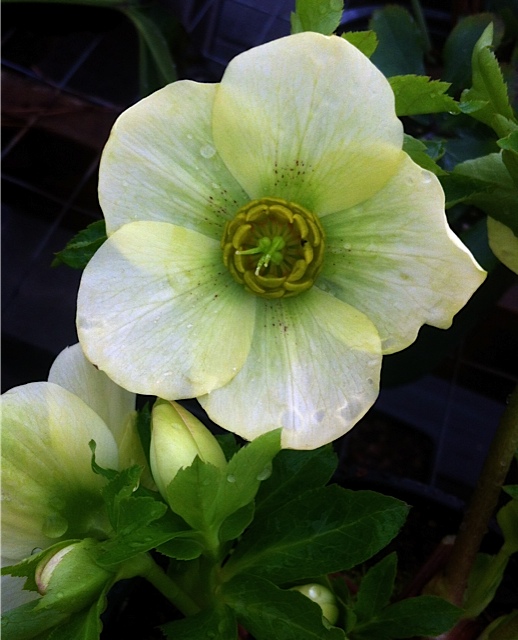 No matter what you might fancy, there is probably a hellebore that will appeal to you. Hellebores, in my opinion, are part of that group of plants that I call fancy plants. Fancy, as in new hybrids of hosta. Fancy, as in unusual. Like the Rembrandt tulips-although their news is now centuries old. Lots of rare and gorgeous plants that gardeners are prone to become besotted over are not such great growers. But I feel convinced that the new hybrids of hellebores are rugged plants. I feel confident in saying any effort you make to grow them will be rewarded.
No matter what you might fancy, there is probably a hellebore that will appeal to you. Hellebores, in my opinion, are part of that group of plants that I call fancy plants. Fancy, as in new hybrids of hosta. Fancy, as in unusual. Like the Rembrandt tulips-although their news is now centuries old. Lots of rare and gorgeous plants that gardeners are prone to become besotted over are not such great growers. But I feel convinced that the new hybrids of hellebores are rugged plants. I feel confident in saying any effort you make to grow them will be rewarded.
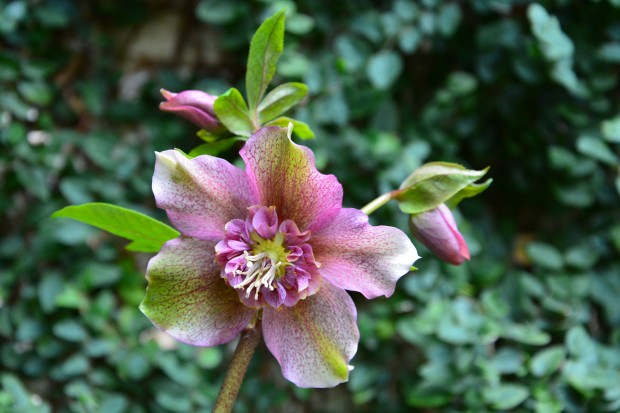 I have never seen one that did not make my heart pound a little faster. This single flower with an anemone center-wow. Though I have always favored green or white single flowered hellebores, I see no good reason not to change my mind. Interested further? The book “Hellebores – A Comprehensive Guide”, written by C. Colston Burrell and Judith Knott Tyler is a classic. Judith’s nursery, Pine Knott Farms, is a major supplier of fine hellebores. Even a casual internet search will provide lots of information and sources for this stellar spring blooming perennial.
I have never seen one that did not make my heart pound a little faster. This single flower with an anemone center-wow. Though I have always favored green or white single flowered hellebores, I see no good reason not to change my mind. Interested further? The book “Hellebores – A Comprehensive Guide”, written by C. Colston Burrell and Judith Knott Tyler is a classic. Judith’s nursery, Pine Knott Farms, is a major supplier of fine hellebores. Even a casual internet search will provide lots of information and sources for this stellar spring blooming perennial.
 Rob always has a fresh idea for Detroit Garden Works. This winter has been so severe and so long, I doubt anyone will be turning over the dirt much in March. The freezing and snowy landscape notwithstanding, every gardener will be ready to talk plants the first day we hit 40 degrees. He has a plan for a big opportunity for some gardening conversation. In late March, we will have over 600 hellebores available for review and purchase. A helleborus Festivalis.
Rob always has a fresh idea for Detroit Garden Works. This winter has been so severe and so long, I doubt anyone will be turning over the dirt much in March. The freezing and snowy landscape notwithstanding, every gardener will be ready to talk plants the first day we hit 40 degrees. He has a plan for a big opportunity for some gardening conversation. In late March, we will have over 600 hellebores available for review and purchase. A helleborus Festivalis.
 Every gardener has a big interest in plants. The plants are a bridge where every gardener of every persuasion might meet. That bridge is a place to be. A chance to move from where we are, given a little conversation and exchange, to where or how we might want to be gardening. We hope you are able to join us March 22nd and 23rd at Detroit Garden Works for a little taste of the spring to come.
Every gardener has a big interest in plants. The plants are a bridge where every gardener of every persuasion might meet. That bridge is a place to be. A chance to move from where we are, given a little conversation and exchange, to where or how we might want to be gardening. We hope you are able to join us March 22nd and 23rd at Detroit Garden Works for a little taste of the spring to come.
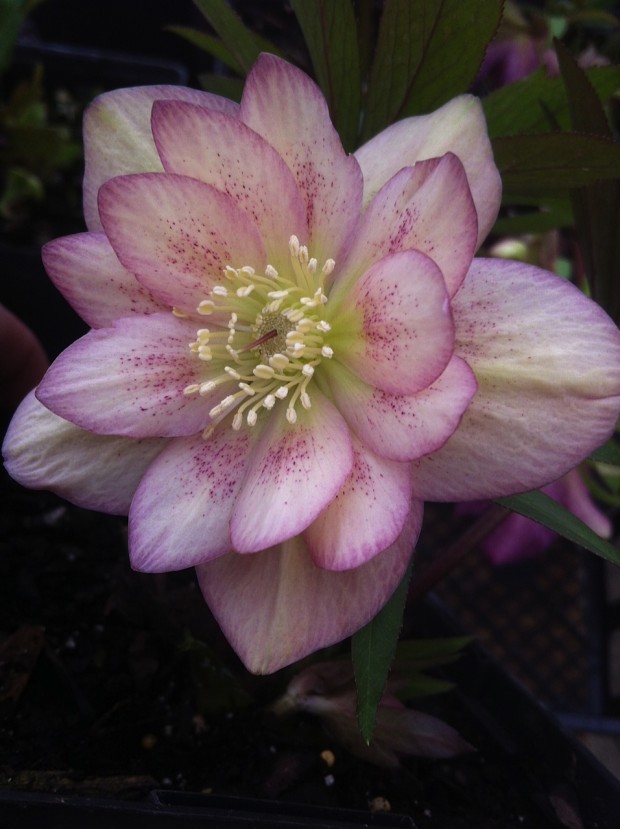 A double pink hellebore might be just the thing to chase away the late winter blues.
A double pink hellebore might be just the thing to chase away the late winter blues.
